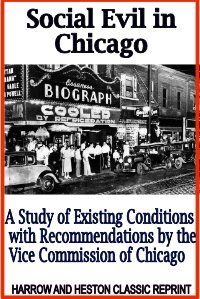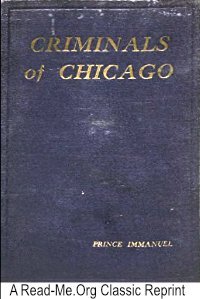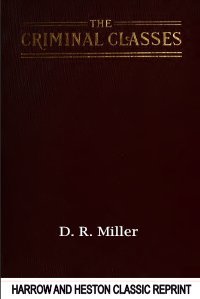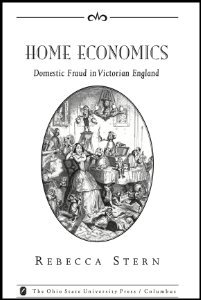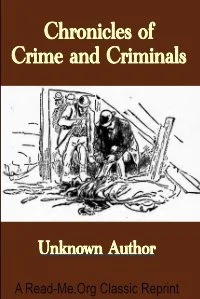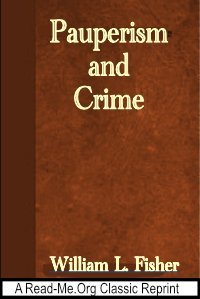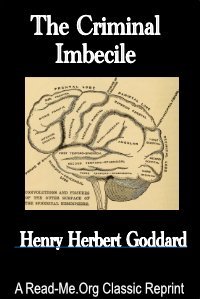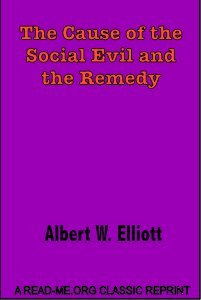By Prince Emmanuel of Jerusalem.
“ History shows that hanging did not prevent petit larceny. So we have abandoned the policy of frightfulness in punishment and cannot revert to it even though it still has some few supporters. And yet we feel that the theory of punishment being deterrent is philosophically sound. …The first news from the Laboratory revealed the prevalence of feeble-mindedness among delinquents. “
Rosburgh Publishing (1921) 247 pages.
By D. R. Miller.
“A law demanding only a refrain from violence or abstinence from all that may injure others contains but the negative, while it is lacking in the more important, the positive elements. If men, by closing their eyes to the existence of evil, could thereby banish it, then might it be best for all to close their eyes….it is quite certain that we can never hope to discover, through ignorance, what are the various types of criminal abnormality, nor know the many causes or cures for such estrangements. An intelligent and thorough study of the criminal problem will eliminate from our creed that fatalistic formula which asserts that ‘Evil is good not understood’…”
United Brethren Publishing House (1903) 224 pages.
By Carl Murchison.
“This material is offered for the special consideration of lawyers, psychologists, siociologists, social workers, and all those who have to do with the formulation of criminal law, the treatment of criminals, and the molding of public opinion concerning the enemies of organized society…”
A Read-Me.Org Classic Reprint (1926) 483 pages.
By Filson Young.
With notes and introduction by Filson Young. “Most of the interest and part of the terror of great crime are due not to what is abnormal, but to what is normal in it; what we have in common with the criminal, rather than that subtle insanity which differentiates him from us, is what makes us view with so lively an interest a fellow-being who has wandered into these tragic and fatal fields.”
William Hodge (1910) 266 pages.
By Clarence Darrow.
“The physical origin of such abnormalities of the mind as are called ‘criminal’ is a comparatively new idea….It has not been long since insanity was treated as a moral defect….”My main effort is to show that the laws that control human behavior are as fixed and certain as those that control the physical world…”
Thomas Crowell Pubs. (1922) 225 pages.
By Ida Well-Barnett.
“Immediately after the awful barbarism which disgraced the State of Georgia in April of last year, during which time more than a dozen colored people were put to death with unspeakable barbarity, I published a full report showing that Sam Hose, who was burned to death during that time, never committed a criminal assault, and that he killed his employer in self- defense.”
Harrow and Heston Classic Reprint (1892) 63 pages.
By Horace M. Kallen.
A Manual for Judges, Practitioners, and Students, by Hans Gross. Translated from the 4th German edition . Introduction By Joseph Jastrow,. “ In short, the individualization of disease, in cause and in treatment, is the dominant truth of modern medical science. The same truth is now known about crime…” Published under the Auspices of The American institute of criminal law and criminologyBoston,
Little Brown and Co. (1911) 567 pages.
Translated by Gina Lombroso.
This is the classic work of the “father of criminology” Cesare Lombroso translated from the Italian by his daughter Gina Lombroso. Here was the idea of the “born criminal” and a detailed classification system according to body types and other physiological and physical features. The major work was “L’Uomo delinquente” that emphasized the atavistic origins of criminality.
NY. Harrow and Heston Classic Reprint. (1876) 251 pages.
By Rebecca Stern.
In Home Economics: Domestic Fraud in Victorian England, Rebecca Stern establishes fraud as a basic component of the Victorian popular imagination, key to its intimate, as well as corporate, systems of exchange. Although Victorian England is famous for revering the domestic realm as a sphere separate from the market and its concerns, actual households were hardly isolated havens of fiscal safety and innocence. Rather, the Victorian home was inevitably a marketplace, a site of purchase, exchange, and employment in which men and women hired or worked as servants, contracted marriages, managed children, and obtained furniture, clothing, food, and labor. Alongside the multiplication of joint-stock corporations and the rise of a credit-based economy, which dramatically increased fraud in the Victorian money market, the threat of swindling affected both actual household commerce and popular conceptions of ostensibly private, more emotive forms of exchange. Working with diverse primary material, including literature, legal cases, newspaper columns, illustrations, ballads, and pamphlets, Stern argues that the climate of fraud permeated Victorian popular ideologies about social transactions. Beyond providing a history of cases and categories of domestic deceit, Home Economics illustrates the diverse means by which Victorian culture engaged with, refuted, celebrated, represented, and consumed swindling in familial and other household relationships.
Columbus, OH: Ohio State University Press, 2008. 207p.
Edited by CALS (Coalition of African Lesbians) and AMSHeR.
Violence against sexual minorities in Africa is rife. Persons belonging to or perceived to be members of the broad grouping ‘lesbian, gay, bisexual, transgender and intersex (LGBTI)’ are often victim of violence in African states. This violence is sometimes perpetrated by state actors, such as the members of the Police force, and more often by ordinary persons (non-state actors). By condoning violence by state actors, and by failing to diligently investigate, prosecute and punish the perpetrators of these acts, states fail to respect the basic right to security of some of its citizens. By condoning these actions, or by failing to act effectively, the state also violates its human rights obligations. The argument of this report is not that sexual minorities deserve special protection, but that they are entitled to the rights all other citizens have – the right to security, liberty, life, dignity, and a fair trial.
As members of the African Union, states are party to and should abide by their obligations under the African Charter on Human and Peoples’ Rights (African Charter). Like several other regional and international human rights instruments, the African Charter guarantees freedom from discrimination, and equal protection and equality of individuals and peoples’ before the law (articles 2, 3 and 19). The African Commission on Human and Peoples’ Rights (African Commission), the body monitoring compliance with the African Charter, has in various communications presented to it denounced acts of discrimination on several of the listed grounds of discrimination and has clearly established that ‘other status’ (in article 2 of the Charter) can be broadly interpreted to include grounds other than those explicitly listed under that provision of the African Charter. The Commission made its first pronouncement on sexual orientation and gender identity (SOGI) issues in its Concluding Observations on Cameroon’s periodic report of 2005 by expressing concern about the upsurge in intolerance towards sexual minorities. Most recently, the Chairperson of the Commission issued a statement on in April 2013 stating that the he Commission ‘equally denounces violence committed against individuals based on their sexual orientation as part of its mandate to protect individuals from all forms of violence’.
Pretoria: Pretoria University Law Press, 2013. 57p.
Author Unknown.
Remarkable criminal trials, mysterious murders, wholesale murders, male and female poisoners, forgery and counterfeiting, bank and post office robberies, swindlers, highway robbery and railway crimes. Full and Authentic Account of the Murder by Henry Wainwright^ of his Mistress Harriet Lane: and an extended account of the the Whitechapel Murders by the infamous Jack the Ripper.
Toronto: Beaver Publishing Co., 1895. 38p.
By Frederick Howard Wines.
"Miscellaneous documents of the House of Representatives for the first session of the fifty-second Congress, 1891-92, volume 50, part 14…..This entire report treats of prisons, juvenile reformatories; almshouses; and benevolent institutions, together with insane paupers in institutions for the insane."
Washington, DC: GPO, 1896. 440p.
By Henry Herbert Goddard.
This book is offered to the public in the belief that the three cases herein described are typical of a large proportion of criminal cases and that the analysis and discussion at- tempted will help to make clear important points which are often misunderstood, points relative to the criminal and to the imbecile. A clear conception of the nature of the imbecile and of his relation to crime will inevitably result in a most desirable change in our criminal procedure. It should be noted that we use "imbecile" in the legal sense which includes the moron and often the idiot as scientifically classified. This usage is justified since much of the literature still describes all mental defectives as imbeciles, idiots, or feeble-minded —according to the preference of the writers. These cases are unique in that they were the first court cases in which the Binet-Simon tests were admitted in evidence, the mental status of these persons under indictment being largely determined by this method.
New York: Macmillan, 1916.188p.
By Albert Borowitz.
This is the first book-length study of an important early Victorian criminal case: the murder of Patrick O'Connor in Bermondsey (South London) by his mistress Marie Manning and her husband. Set in the midst of the raging cholera epidemic of 1849, the case stirred the passionate interest of all sectors of British society, including writers and public figures. Notable among students of the case was Charles Dickens, who based his characterization of Mile Hortense, the murderess in Bleak House, on the personality of Mrs. Manning. The Manning case represents a remarkable chapter in the social history of England. The apprehension of the Mannings was a major early triumph of Scotland Yard; and the efficient detective work, featuring the use of the newly invented electric telegraph, as well as pursuits by sea and rail, confirmed the early Victorian sense of security and the belief in progress based on science. At the same time, the case stirred controversy in a number of respects. The intensive coverage of the murder by a sensation-mongering press led to public outcries against the commercialization of crime; and the brutish behavior of the crowd at the Mannings' execution sharpened partisan feelings on the issue of capital punishment. Dickens was inspired to write his famous letters to the Times advocating an end to public hangings, and was denounced in turn by absolutist supporters of the abolition of the death penalty.
Columbus, OH: Ohio State University Press, 1981. 337p.
By Albert W. Elliott.
“In the following pages, I purpose to lay bare the stark facts of the Social Evil, believing that public knowledge of conditions as they really are will prove a power for good; I will strive to tell the unflinching truth, pitiless though it appears, for therein lies the world’s only hope of freedom from error and vice. This book, my reader, is meat for strong men, not milk for babes. The author has devoted six years of his life to rescue work among fallen women, has studied the underworld from New Orleans to New York, from the Atlantic to the Pacific ; has entered on the course of his mission, more than three thousand houses of shame and talked with more than fifteen thousand inmates ; he has walked the valley of this terrible shadow meeting its blackened spirits face to face, searching their innermost secrets, praying and working for their deliverance, and crying from the depth of his soul over the hopeless tragedy of it all. Of the intimate, accurate, heart-crushing ex- perience thus gathered, this book is a faithful record.”
Atlanta, GA: Webb & Vary Co., 1914..


